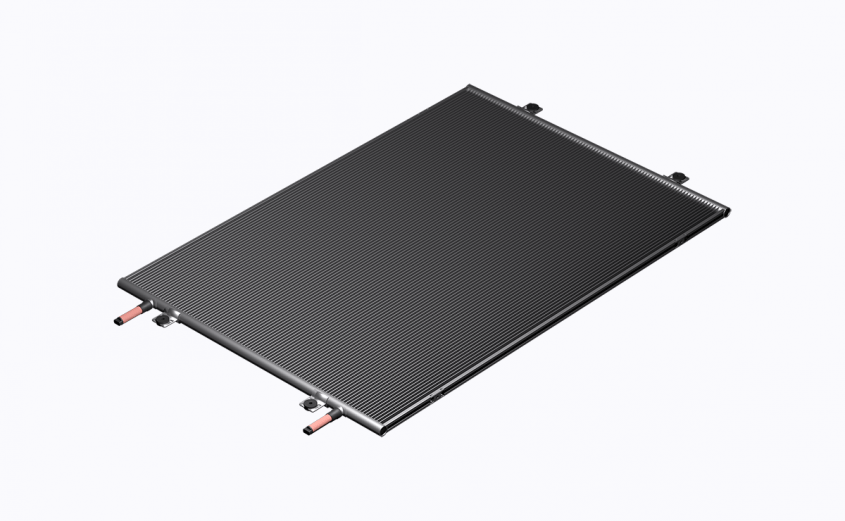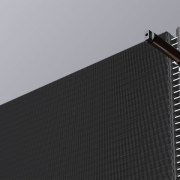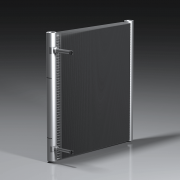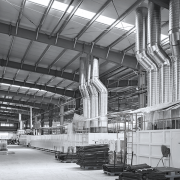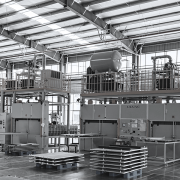Microchannel heat exchangers as an advanced alternative to traditional HVAC coils
Introduction
For over three decades now, air-to-refrigerant microchannel heat exchangers have been successfully used in a number of industries, including automotive and chemical processing. More than a decade ago, microchannel heat exchangers were introduced in the HVAC industry; but it must be noted that requirements concerning heat exchangers and their operating conditions in refrigeration and air conditioning systems are different from those applicable in the automotive and other industries. Because of this, the first adaptations of microchannel heat exchangers to HVAC applications, principally as condensers, were not entirely successful.
Initial experience with microchannel heat exchangers demonstrated that their design should be reconsidered, and that the aluminium alloys used should be replaced with new ones which are more suitable for HVAC system requirements and operating conditions of the HVAC equipment. Adapting microchannel heat exchangers to the refrigerants used in HVAC systems, adapting to different air velocities and avoiding condensate build-up issues, all required substantial design changes in order to make heat exchangers that would exhibit all the advantages particular to microchannel technology and be suitable for use not only as condenser coils, but also as direct expansion evaporators, water coils, and as the heat exchangers in heat pump applications.
The equipment used in the manufacturing of microchannel heat exchangers also needed to be replaced; for instance, the automobile industry has no need of heat exchangers with large surface areas, which are required in many refrigeration systems. Therefore, the production required new equipment and larger CAB (CAB – controlled atmosphere brazing) furnaces for brazing the large coils. In turn, increasing the dimensions of microchannel heat exchanger led to some technical constraints, including the refrigerant maldistribution along microchannel tubes, high tube-side pressure drops, and unpredictable part load performance.
As a result of intensive research, the subsequent development of a new design of microchannel heat exchanger and the re-equipment of production lines, Kaltra entered the market with a series of new, advanced products: microchannel heat exchangers suitable for use as condensing coils, DX evaporators, heat pump coils, and water coils for cooling and heating applications. These overcame the issues of refrigerant maldistribution and bridging the fins with condensate water. The corrosion resistance of the new microchannel heat exchangers has been improved fundamentally with the new aluminium alloys used in the design. For manufacturing the heat exchangers of the large size, the new CAB furnaces designed to handle high volume production runs per shift have been installed.
Below we examine the benefits of the new microchannel heat exchangers, their design highlights, and certain aspects of their use in HVAC systems.
Design
The core of a microchannel heat exchanger consists of two headers, namely the inlet and outlet headers, flat microchannel multiport tubes, and fins, brazed together with the non-corrosive fluxes. All above elements made of aluminium alloys, distinct in their composition and clads.
Depending on the required performance and application, the heat exchangers are manufactured with:
- Different fin types and fin pitches
- Microchannel tubes of different widths varying by the number of ports and port sizes
- Headers with the different geometry and internal structure
The header design depends on the purpose of the heat exchanger. Thus, evaporator coils for direct expansion and heat pump applications have a built-in refrigerant distributor that provides the uniform feeding of microchannel tubes and ensures optimal heat exchanger performance in part load and full load conditions.
In condenser coils, the lower header acts as a receiver for the liquid refrigerant. The receiver is designed to hold in gas, thus supplying the outlet only with liquid-phase refrigerant. Constructing the header in this way reduces the critical refrigerant charge issues and optimizes condenser coil performance during the part load operation.
For water coils, large-diameter headers are used, ensuring the low waterside pressure drops and uniform water distribution across the microchannel tubes.
In the new design of heat exchangers, the microchannel tubes are arranged vertically, thus ensuring stable and predictable performance as well as free condensate shedding and preventing a negative effect on heat exchanger performance.
Advantages Of Microchannel Heat Exchangers
The advantages of using microchannel heat exchangers in HVAC systems is essential indeed and provide far-reaching benefits, including increased equipment efficiency, reduced size and weight of equipment, and lower system end-cost.
High Heat Transfer Ratios
The high heat transfer coefficient in microchannel heat exchangers is due to a set of influencing factors, of which the most significant are:
- The method used to manufacture the microchannel heat exchangers (brazed assembly). The contact between the tubes and fins of a traditional finned tube heat exchanger is mechanical, while the manufacture of the microchannel heat exchanger involves brazing, which provides the metallurgical bond between tubes and fins, eliminates contact resistance, and thus ensures higher heat transfer.
- Use of flat multi-port microchannel tubes of submillimeter diameter. The most intensive heat transfer between refrigerant and tubes happens along the tube walls, with noticeably less heat transfer in the center of the refrigerant flow. In single-phase heat transfer, the key role is played by tube diameter: the smaller the diameter, the greater the heat transfer coefficient. In two-phase heat transfer, the most significant effect on heat transfer ratio is produced by refrigerant flow regime. In the light of the fact that microchannel tubes have a smaller diameter than the copper tubes of a finned tube heat exchanger, and the surface tension causes stratified flow in the microchannel, the heat transfer performance of microchannel heat exchanger is higher both in single-phase heat transfer and in two-phase heat transfer.
- Use of fins made from louvered plate periodically folded and then bonded to the surface of the flat microchannel tube. The geometry of louvered fins ensures a heat transfer coefficient 50% higher than with the rectangular fins used in the construction of finned tube heat exchangers. Louvered fins also reduce airflow turbulence and minimize air shadows. Combined with flat streamlined microchannel tubes with the low pressure drag, louvered fins also produce lower airside pressure drop.
Low Airside Pressure Drops
Low airside resistance is yet another significant benefit of microchannel heat exchangers compared with traditional HVAC coil designs. If we compare a microchannel heat exchanger with a 6-row finned tube heat exchanger of similar size and capacity, the microchannel heat exchanger demonstrates 60% less airside pressure drop and therefore reduces fan power consumption as well as noise level produced by the fans. Thanks to the low resistance it is possible to increase airflow through a microchannel heat exchanger in order to increase the capacity of the cooling system.
Close Approach Temperatures
The same features that give the microchannel heat exchanger its high efficiency also makes it possible to reach close approach temperatures between the air and refrigerant which is particularly important in HVAC applications.
Smaller Sizes, Compact Design
Microchannel heat exchangers with 32-mm tube width provide the almost equal performance as 6-row finned tube heat exchanger with the same face area. To replace a traditional heat exchanger with the lower number of rows, a smaller and therefore less costly microchannel heat exchanger can be used. Depending on the application, this may also permit to increase the heat exchanging surface, leading to unprecedented increases in performance and/or energy efficiency of the HVAC system.
Low Refrigerant Charge
The internal volume of a microchannel heat exchanger is significantly less compared with that of a traditional finned tube heat exchanger. This is achieved by using microchannel tubes less than 1mm in diameter, while the diameter of copper pipes used in plate heat exchangers is way higher. With the introduction of directives limiting the use of HFC refrigerants and the advent of considerably costlier low-GWP, zero ozone depletion potential refrigerants, reducing the volume of the heat exchanger not only makes the equipment more ecologically safe but also reduces its end cost.
High Corrosion Resistance
Initial experience of using microchannel heat exchangers without protective coating has shown that their corrosion resistance is insufficient in cases of seashore installations, and in polluted atmospheres in industrial areas.
Increased corrosion resistance is provided by e-coating. E-coating is used for decades throughout the automobile industry to protect the car radiators. Tests conducted in accordance with the requirements of SWAAT ASTM G-85 A3 show that e-coated microchannel coils did not produce any leakage during 4000-hour tests.
E-coating is a process that uses an electrical current to deposit an organic coating from a paint bath onto a heat exchanger body. Due to the ability to penetrate recesses and coat geometrically complex parts, electrocoating is used throughout various industries to coat a wide range of products including those in automotive, home appliance, marine and many other. Electrocoating, and specifically cathodic electrocoating, has enabled a remarkable improvement in corrosion resistance for microchannel heat exchangers over other coating methods.
The use of special long-life aluminium alloys and non-corrosive fluxes in the manufacturing process of microchannel heat exchangers also provides significant corrosion resistance compared with heat exchangers produced using the 3000/3xxx aluminium-manganese alloys. New alloys double the lifetime of heat exchangers produced using them, according to the ASTM G-85 A3 tests conducted.
Microchannel heat exchangers we offer have a wall thickness 40% higher than others available on the market. This not only provides additional corrosion resistance but also protects against mechanical damages.
The cleaning procedure for microchannel heat exchanger is easy and quick due to its low thickness and usually doesn’t require disassembling the unit. This helps to maintain the cleanliness, thus ensuring the optimum unit performance, protecting the heat exchanger from the corrosion caused by contamination, and extending its lifespan.
Robust Construction
In contrast to traditional finned tube heat exchangers, the core of a microchannel heat exchanger is extremely robust; the fins of microchannel heat exchangers are well protected from bending and mechanical damaging.
Low Weight
The low weight, compact size and reduced internal volume of an all-aluminum microchannel heat exchanger were key factors in its dramatic increase in popularity in the automobile industry. These characteristics are significant indeed and in the field of cooling systems, especially when it comes to mobile cooling systems. Their reduced size and weight lead not only to the lower transport and handling costs but also to the reduced cost of labour.
Lower Equipment Cost
The above-mentioned advantages of microchannel heat exchangers have led to a reduction in the overall cost of the equipment, which benefits from smaller heat exchanger size, reduced refrigerant charges, use of smaller fans, and a reduction in the number of parts used in the construction. It must be also noted that the cooling units based on microchannel heat exchangers allow elimination of some elements from; for instance, direct expansion systems do not require a refrigerant distributor anymore, a component that is both fragile and expensive in terms of labour cost.
Experience shows that the end cost of equipment that uses microchannel heat exchangers is at least 10% lower than that of equipment based on traditional heat exchangers.
Summary
We currently offer new-generation microchannel heat exchangers designed for the condenser, DX evaporator, heat pump, and water coil applications. They are suitable for use with HFC, HFO, and natural refrigerants, water, glycol mixtures, oils, and other working fluids. New braze furnaces allow us to produce large-size heat exchangers, up to 4800 mm long and 2000 mm high, with the microchannel tubes of different widths and a fin pitch of 10 and 24FPI. Heat exchangers with these parameters cover almost the full range of HVAC applications, be it stationary or mobile system, including air-cooled chillers, heat pumps, dry coolers, condensers, and air conditioning units.
The benefits of cooling equipment based on microchannel coils are fundamental, and the reliability and corrosion resistance of the modern microchannel heat exchangers have been tested and are beyond doubt.

